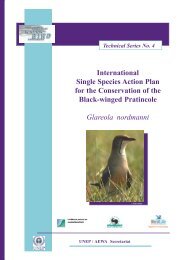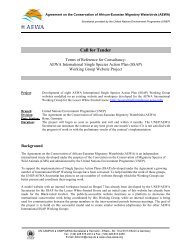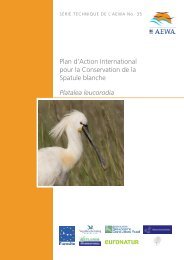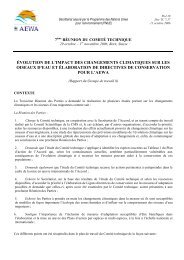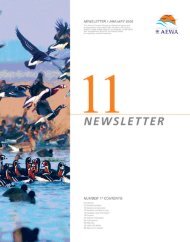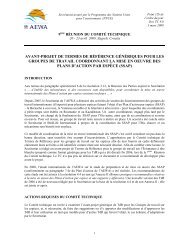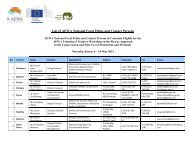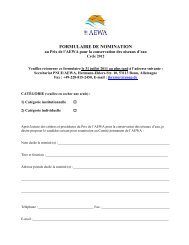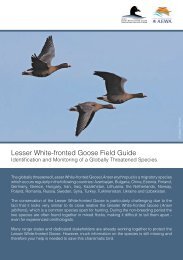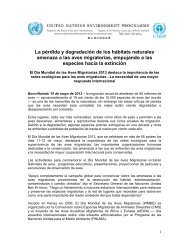The quick brown fox jumps over the lazy dog - AEWA
The quick brown fox jumps over the lazy dog - AEWA
The quick brown fox jumps over the lazy dog - AEWA
Create successful ePaper yourself
Turn your PDF publications into a flip-book with our unique Google optimized e-Paper software.
Secretariat provided by <strong>the</strong><br />
United Nations Environment Programme (UNEP)<br />
Doc StC 7.DR16 Rev. 1<br />
Agenda item 15<br />
15 November 2011<br />
7 th MEETING OF THE <strong>AEWA</strong> STANDING COMMITTEE<br />
26 – 27 November 2011, Bergen, Norway<br />
DRAFT RESOLUTION 5.XX<br />
ADOPTION OF AMENDMENTS TO THE <strong>AEWA</strong> ACTION PLAN<br />
Recalling Article X of <strong>the</strong> Agreement concerning <strong>the</strong> procedures for amendments to <strong>the</strong> Agreement<br />
and its annexes,<br />
Fur<strong>the</strong>r recalling Resolution 4.1 which, inter alia, requested <strong>the</strong> Technical Committee to examine, as<br />
far as waterbird species c<strong>over</strong>ed by <strong>the</strong> Agreement are concerned, any potential problems from <strong>the</strong> use of<br />
lead fishing weights,<br />
Taking into account <strong>the</strong> recommendations of <strong>the</strong> Literature Review on effects of <strong>the</strong> use of lead<br />
fishing weights on waterbirds and wetlands, which was prepared by <strong>the</strong> Secretariat intersessionally on<br />
request of <strong>the</strong> Technical Committee (document <strong>AEWA</strong>/MOP Inf. XX),<br />
Recalling Resolution 4.3 which, inter alia, requested <strong>the</strong> Technical Committee to review and to<br />
provide guidance on <strong>the</strong> interpretation and implications of <strong>the</strong> Action Plan‟s provisions related to hunting<br />
and trade as specified in Annex 1 to <strong>the</strong> same Resolution,<br />
Recalling also Resolution 4.11 which, inter alia, requested <strong>the</strong> Technical Committee to review<br />
ornithological data on <strong>the</strong> Little Tern Sterna albifrons for a better delineation of <strong>the</strong> Mediterranean<br />
populations taking into account <strong>the</strong> relevant information concerning <strong>the</strong> Italian breeding population and to<br />
draft a consequent proposal for amendments to Table 1, as appropriate, to be presented to <strong>the</strong> 5 th Session of<br />
<strong>the</strong> Meeting of <strong>the</strong> Parties; to review <strong>the</strong> definitions of geographical terms used in range descriptions of<br />
populations in Table 1 and to draft a consequent proposal for amendments to Table 1, as appropriate, to be<br />
presented to <strong>the</strong> 5 th Session of <strong>the</strong> Meeting of <strong>the</strong> Parties; to review, in <strong>the</strong> light of <strong>the</strong> development of<br />
terminology used by IUCN for Red Data Lists, as a matter of priority, <strong>the</strong> applicability of <strong>the</strong> threat criteria,<br />
especially <strong>the</strong> Near Threatened IUCN Category, to <strong>the</strong> listing of populations in Table 1 and to present<br />
options for <strong>the</strong> amendment of Table 1 to be considered at <strong>the</strong> 5 th Session of <strong>the</strong> Meeting of <strong>the</strong> Parties; and to<br />
draft a proposal for amendments to <strong>the</strong> <strong>AEWA</strong> Action Plan to deal with tackling <strong>the</strong> effects of aquatic<br />
invasive non-native species on waterbird habitats to be presented to <strong>the</strong> 5 th Session of <strong>the</strong> Meeting of <strong>the</strong><br />
Parties,<br />
Fur<strong>the</strong>r recalling Resolution 4.12 which, inter alia, requested <strong>the</strong> Technical Committee, using<br />
external assistance as necessary and appropriate, and resources permitting, to develop guidance for<br />
interpretation of <strong>the</strong> term “extreme fluctuations in population size or trend” used in Table 1 of <strong>the</strong> Action<br />
Plan,<br />
Recognising <strong>the</strong> work of <strong>the</strong> Technical Committee <strong>over</strong> <strong>the</strong> past four years to address <strong>the</strong>se requests,<br />
Taking into account <strong>the</strong> findings of <strong>the</strong> fifth edition of <strong>the</strong> Report on <strong>the</strong> Conservation Status of<br />
Migratory Waterbirds in <strong>the</strong> Agreement area (document <strong>AEWA</strong>/MOP XX),<br />
Acknowledging <strong>the</strong> proposals for amendments to Annex 3 (Action Plan and Table 1) submitted by<br />
Kenya and <strong>the</strong> comments received from Contracting Parties [if any] concerning <strong>the</strong>se proposals, all of which<br />
are presented in document <strong>AEWA</strong>/MOP XX.
<strong>The</strong> Meeting of <strong>the</strong> Parties:<br />
1. Adopts <strong>the</strong> revised text of <strong>the</strong> paragraphs 2.1, 2.5, 3.3, 4.1 and 4.3 of <strong>the</strong> Action Plan as appended to<br />
<strong>the</strong> present Resolution as Appendix I, to replace <strong>the</strong> current paragraphs 2.1, 2.5, 3.3 and 4.1 of <strong>the</strong> Action<br />
Plan;<br />
2. Adopts <strong>the</strong> revised version of Table 1 of <strong>the</strong> Action Plan appended to <strong>the</strong> present Resolution as<br />
Appendix II, to replace <strong>the</strong> current Table 1 of <strong>the</strong> Action Plan;<br />
3. Adopts <strong>the</strong> amendments to <strong>the</strong> scientific names of <strong>the</strong> Lesser Flamingo, changed to Phoeniconaias<br />
minor, <strong>the</strong> Terek Sandpiper, changed to Xenus cinereus and <strong>the</strong> Common Sandpiper, changed to Actitis<br />
hypoleucos, in Table 1 and Annex 2 of <strong>the</strong> Agreement;<br />
4. Requests <strong>the</strong> Secretariat to monitor <strong>the</strong> implementation of <strong>the</strong> amendments.<br />
2
Appendix I<br />
Annex 3<br />
ACTION PLAN<br />
[…]<br />
2. Species Conservation<br />
2.1 Legal measures<br />
2.1.1 Parties with populations listed in column A of Table 1 shall provide protection to those populations<br />
listed in accordance with Article III, paragraph 2(a), of this Agreement. Such Parties shall in particular<br />
and subject to paragraph 2.1.3 below:<br />
(a) prohibit <strong>the</strong> taking of birds and eggs of those populations occurring in <strong>the</strong>ir territory;<br />
(b) prohibit deliberate disturbance in so far as such disturbance would be significant for <strong>the</strong><br />
conservation of <strong>the</strong> population concerned; and<br />
(c) prohibit <strong>the</strong> possession or utilization of, and trade in, birds or eggs of those populations which have<br />
been taken in contravention of <strong>the</strong> prohibitions laid down pursuant to subparagraph (a) above, as<br />
well as <strong>the</strong> possession or utilization of, and trade in, any readily recognizable parts or derivatives of<br />
such birds and <strong>the</strong>ir eggs.<br />
2.1.2 By way of exception for:<br />
(a) those populations listed in Categories 2 and 3 in Column A and which are marked by an asterisk,<br />
and<br />
(b) those populations listed in Category 4 in Column A,<br />
hunting may continue to be conducted on a sustainable use basis 1 . This sustainable use shall be<br />
conducted within <strong>the</strong> framework of special provisions of an international species action plan, which<br />
shall seek to implement <strong>the</strong> principles of adaptive harvest management. 2 Such use shall, at a minimum,<br />
be subject to <strong>the</strong> same legal measures as <strong>the</strong> taking of birds from populations listed in column B of Table<br />
1, as required in paragraph 2.1.3 below.<br />
2.1.3 Parties with populations listed in Table 1 shall regulate <strong>the</strong> taking of birds and eggs of all populations<br />
listed in column B of Table 1. <strong>The</strong> object of such legal measures shall be to maintain or contribute to <strong>the</strong><br />
restoration of those populations to a favourable conservation status and to ensure, on <strong>the</strong> basis of <strong>the</strong><br />
best available knowledge of population dynamics, that any taking or o<strong>the</strong>r use is sustainable. Such legal<br />
measures, subject to paragraph 2.1.4 below, shall in particular:<br />
(a) prohibit <strong>the</strong> taking of birds belonging to <strong>the</strong> populations concerned during <strong>the</strong>ir various stages of<br />
reproduction and rearing and during <strong>the</strong>ir return to <strong>the</strong>ir breeding grounds if <strong>the</strong> taking has an<br />
unfavourable impact on <strong>the</strong> conservation status of <strong>the</strong> population concerned;<br />
1 “Sustainable use” means <strong>the</strong> use of components of biological diversity in a way and at a rate that does not lead to <strong>the</strong><br />
long-term decline of biological diversity, <strong>the</strong>reby maintaining its potential to meet <strong>the</strong> needs and aspirations of present<br />
and future generations.<br />
2 Adaptive Harvest Management is <strong>the</strong> periodic process of setting hunting regulations based on a system of population<br />
and habitat monitoring, harvest level recording, data analysis and defining regulatory options.<br />
3
(b) regulate <strong>the</strong> modes of taking, and in particular prohibit <strong>the</strong> use of all indiscriminate means of taking<br />
and <strong>the</strong> use of all means capable of causing mass destructions, as well as local disappearance of, or<br />
serious disturbance to, populations of a species, including:<br />
- snares,<br />
- limes,<br />
- hooks,<br />
- live birds which are blind or mutilated used as decoys,<br />
- tape recorders and o<strong>the</strong>r electronic devices,<br />
- electrocuting devices,<br />
- artificial light sources,<br />
- mirrors and o<strong>the</strong>r dazzling devices,<br />
- devices for illuminating targets,<br />
- sighting devices for night shooting comprising an electronic image magnifier or image<br />
converter,<br />
- explosives,<br />
- nets,<br />
- traps,<br />
- poison,<br />
- poisoned or anes<strong>the</strong>tic bait,<br />
- semi-automatic or automatic weapons with a magazine capable of holding more than two<br />
rounds of ammunition,<br />
- hunting from aircraft, motor vehicles, or boats driven at a speed exceeding 5km p/h (18km p/h<br />
on <strong>the</strong> open sea).<br />
Parties may grant exemptions from <strong>the</strong> prohibitions laid down in paragraph 2.1.3 (b) to<br />
accommodate use for livelihood purposes, where sustainable.<br />
(c) establish limits on taking, where appropriate, and provide adequate controls to ensure that <strong>the</strong>se<br />
limits are observed; and<br />
(d) prohibit <strong>the</strong> possession or utilization of, and trade in, birds and eggs of <strong>the</strong> populations which have<br />
been taken in contravention of any prohibition laid down pursuant to <strong>the</strong> provisions of this<br />
paragraph, as well as <strong>the</strong> possession or utilization of, and trade in, any readily recognizable parts or<br />
derivatives of such birds and <strong>the</strong>ir eggs.<br />
2.1.4 Parties may grant exemptions to <strong>the</strong> prohibitions laid down in paragraphs 2.1.1 and 2.1.3, irrespective of<br />
<strong>the</strong> provisions of Article III, paragraph 5, of <strong>the</strong> Convention, where <strong>the</strong>re is no o<strong>the</strong>r satisfactory<br />
solution, for <strong>the</strong> following purposes:<br />
(a) to prevent serious damage to crops, water and fisheries;<br />
(b) in <strong>the</strong> interests of air safety, public health and public safety, or for o<strong>the</strong>r imperative reasons of<br />
<strong>over</strong>riding public interests, including those of a social or economic nature and beneficial<br />
consequences of primary importance to <strong>the</strong> environment;<br />
(c) for <strong>the</strong> purpose of research and education, of re-establishment and for <strong>the</strong> breeding necessary for<br />
<strong>the</strong>se purposes;<br />
(d) to permit under strictly supervised conditions, on a selective basis and to a limited extent, <strong>the</strong> taking<br />
and keeping or o<strong>the</strong>r judicious use of certain birds in small numbers; and<br />
(e) for <strong>the</strong> purpose of enhancing <strong>the</strong> propagation or survival of <strong>the</strong> populations concerned.<br />
Such exemptions shall be precise as to content and limited in space and time and shall not operate to <strong>the</strong><br />
detriment of <strong>the</strong> populations listed in Table 1. Parties shall as soon as possible inform <strong>the</strong> Agreement<br />
secretariat of any exemptions granted pursuant to this provision.<br />
4
[…]<br />
2.5 Introductions<br />
2.5.1 Parties shall prohibit <strong>the</strong> introduction into <strong>the</strong> environment of non-native species of animals and plants<br />
which may be detrimental to <strong>the</strong> populations listed in Table 1.<br />
2.5.2 Parties shall require <strong>the</strong> taking of appropriate precautions to avoid <strong>the</strong> accidental escape of captive birds<br />
belonging to non-native species, which may be detrimental to <strong>the</strong> populations listed in Table 1.<br />
2.5.3 Parties shall take measures to <strong>the</strong> extent feasible and appropriate, including taking, to ensure that when<br />
non-native species or hybrids <strong>the</strong>reof have already been introduced into <strong>the</strong>ir territory, those species or<br />
<strong>the</strong>ir hybrids do not pose a potential hazard to <strong>the</strong> populations listed in Table 1.<br />
[…]<br />
3. Habitat Conservation<br />
3.3 Rehabilitation and Restoration<br />
[…]<br />
Parties shall endeavour to rehabilitate or restore, where feasible and appropriate, areas which were<br />
previously important for <strong>the</strong> populations listed in Table 1 which should include areas that suffer<br />
degradation as a result of <strong>the</strong> impacts of factors such as climate change, hydrological change,<br />
agriculture, spread of aquatic invasive non-native species, natural succession, uncontrolled fires,<br />
unsustainable use, eutrophication and pollution.<br />
4. Management of Human Activities<br />
4.1 Hunting<br />
4.1.1 Parties shall cooperate to ensure that <strong>the</strong>ir hunting legislation implements <strong>the</strong> principle of sustainable use<br />
as envisaged in this Action Plan, taking into account <strong>the</strong> full geographical range of <strong>the</strong> waterbird<br />
populations concerned and <strong>the</strong>ir life history characteristics.<br />
4.1.2 <strong>The</strong> Agreement Secretariat shall be kept informed by <strong>the</strong> Parties of <strong>the</strong>ir legislation relating to <strong>the</strong><br />
hunting of populations listed in Table 1.<br />
4.1.3 Parties shall cooperate with a view to developing a reliable and harmonized system for <strong>the</strong> collection of<br />
harvest data in order to assess <strong>the</strong> annual harvest of populations listed in Table 1. <strong>The</strong>y shall provide <strong>the</strong><br />
Agreement Secretariat with estimates of <strong>the</strong> total annual take for each population, when available.<br />
4.1.4 Parties shall endeavour to phase out <strong>the</strong> use of lead shot for hunting in wetlands as well as <strong>the</strong> use of<br />
lead fishing weights weighing between 0.06 and 28.35 grams as soon as possible in accordance with<br />
self-imposed and published timetables.<br />
4.1.5 Parties shall develop and implement measures to reduce, and as far as possible eliminate, illegal taking.<br />
4.1.6 Where appropriate, Parties shall encourage hunters, at local, national and international levels, to form<br />
clubs or organizations to coordinate <strong>the</strong>ir activities and to help ensure sustainability.<br />
4.1.7 Parties shall, where appropriate, promote <strong>the</strong> requirement of a proficiency test for hunters, including<br />
among o<strong>the</strong>r things, bird identification.<br />
[…]<br />
5
4.3. O<strong>the</strong>r Human Activities<br />
[...]<br />
4.3.4 Parties shall cooperate with a view to developing single species management plans for populations<br />
which cause significant damage, in particular to crops and to fisheries. <strong>The</strong> Agreement secretariat shall<br />
coordinate <strong>the</strong> development and harmonization of such plans.<br />
[...]<br />
6
Appendix II<br />
Table 1 a/<br />
STATUS OF THE POPULATIONS OF MIGRATORY WATERBIRDS<br />
KEY TO CLASSIFICATION<br />
<strong>The</strong> following key to Table 1 is a basis for implementation of <strong>the</strong> Action Plan:<br />
Column A<br />
Category 1: (a) Species, which are included in Appendix I to <strong>the</strong> Convention on <strong>the</strong> Conservation of<br />
Migratory species of Wild Animals;<br />
(b) Species, which are listed as threatened on <strong>the</strong> IUCN Red List of Threatened Species, as<br />
reported in <strong>the</strong> most recent summary by BirdLife International; or<br />
(c) Populations, which number less than around 10,000 individuals.<br />
Category 2:<br />
Category 3:<br />
Populations numbering between around 10,000 and around 25,000 individuals.<br />
Populations numbering between around 25,000 and around 100,000 individuals and<br />
considered to be at risk as a result of:<br />
(a) Concentration onto a small number of sites at any stage of <strong>the</strong>ir annual cycle;<br />
(b) Dependence on a habitat type, which is under severe threat;<br />
(c) Showing significant long-term decline; or<br />
(d) Showing large fluctuations in population size or trend.<br />
Category 4:<br />
Species, which are listed as Near Threatened on <strong>the</strong> IUCN Red List of Threatened species (as<br />
For species listed in categories 2, 3 and 4 above, see paragraph 2.1.2 of <strong>the</strong> Action Plan<br />
contained in Annex 3 to <strong>the</strong> Agreement.<br />
Column B<br />
Category 1:<br />
Category 2:<br />
Populations numbering between around 25,000 and around 100,000 individuals and<br />
which do not fulfil <strong>the</strong> conditions in respect of column A, as described above.<br />
Populations numbering more than around 100,000 individuals and considered to be in need of<br />
special attention as a result of:<br />
(a) Concentration onto a small number of sites at any stage of <strong>the</strong>ir annual cycle;<br />
(b) Dependence on a habitat type, which is under severe threat;<br />
(c) Showing significant long-term decline; or<br />
(d) Showing large fluctuations in population size or trend.<br />
Column C<br />
Category 1:<br />
Populations numbering more than around 100,000 individuals which could<br />
significantly benefit from international cooperation and which do not fulfil <strong>the</strong><br />
conditions in respect of ei<strong>the</strong>r column A or column B, above.<br />
REVIEW OF TABLE 1<br />
a / Table 1, “Status of <strong>the</strong> populations of migratory waterbirds” forms part of <strong>the</strong> Action Plan contained in Annex 3 to <strong>the</strong><br />
Agreement.<br />
7
<strong>The</strong> Table shall be:<br />
(a) Reviewed regularly by <strong>the</strong> Technical Committee in accordance with article VII, paragraph 3(b), of <strong>the</strong><br />
Agreement; and<br />
(b) Amended as necessary by <strong>the</strong> Meeting of <strong>the</strong> Parties, in accordance with article VI, paragraph 9(d) of <strong>the</strong><br />
Agreement, in light of <strong>the</strong> conclusions of such reviews.<br />
DEFINITION OF GEOGRAPHICAL TERMS USED IN RANGE DESCRIPTIONS<br />
Note that waterbird ranges respect biological, not political, boundaries and that precise alignment of<br />
biological and political entities is extremely unusual. <strong>The</strong> range descriptions used have no political<br />
significance and are for general guidance only, and for concise, mapped summaries of waterbird ranges,<br />
practitioners should consult <strong>the</strong> Critical Site Network Tool internet portal:<br />
http://wow.wetlands.org/informationflyway/criticalsitenetworktool/tabid/1349/language/en-US/Default.aspx<br />
North Africa<br />
West Africa<br />
Eastern Africa<br />
North-west Africa<br />
North-east Africa<br />
Sou<strong>the</strong>rn Africa<br />
Central Africa<br />
Sub-Saharan Africa<br />
Tropical Africa<br />
Western Palearctic<br />
North-west Europe<br />
Western Europe<br />
North-east Europe<br />
North Europe<br />
Eastern Europe<br />
Algeria, Egypt, Libya, Morocco, Tunisia.<br />
Benin, Burkina Faso, Cameroon, Cape Verde, Chad, Côte d'Ivoire, <strong>the</strong> Gambia,<br />
Ghana, Guinea, Guinea-Bissau, Liberia, Mali, Mauritania, Niger, Nigeria, Senegal,<br />
Sierra Leone, Togo.<br />
Burundi, Djibouti, Eritrea, Ethiopia, Kenya, Rwanda, Somalia, South Sudan, Sudan,<br />
Uganda, <strong>the</strong> United Republic of Tanzania.<br />
Morocco, Algeria and Tunisia.<br />
Djibouti, Egypt, Eritrea, Ethiopia, Somalia, South Sudan, Sudan.<br />
Angola, Botswana, Lesotho, Malawi, Mozambique, Namibia, South Africa,<br />
Swaziland, Zambia, Zimbabwe.<br />
Cameroon, Central African Republic, Congo, Democratic Republic of <strong>the</strong> Congo,<br />
Equatorial Guinea, Gabon, Sao Tome and Principe.<br />
All African states south of <strong>the</strong> Sahara.<br />
Sub-Saharan Africa excluding Lesotho, Namibia, South Africa and Swaziland.<br />
As defined in Handbook of <strong>the</strong> Birds of Europe, <strong>the</strong> Middle East and North Africa<br />
(Cramp & Simmons 1977).<br />
Belgium, Denmark, Finland, France, Germany, Iceland, Ireland, Luxembourg, <strong>the</strong><br />
Ne<strong>the</strong>rlands, Norway, Sweden, <strong>the</strong> United Kingdom of Great Britain and Nor<strong>the</strong>rn<br />
Ireland.<br />
North-west Europe with Portugal and Spain.<br />
<strong>The</strong> nor<strong>the</strong>rn part of <strong>the</strong> Russian Federation west of <strong>the</strong> Urals.<br />
North-west Europe and North-east Europe, as defined above.<br />
Belarus, <strong>the</strong> Russian Federation west of <strong>the</strong> Urals, Ukraine.<br />
8
Central Europe<br />
South-west Europe<br />
South-east Europe<br />
South Europe<br />
North Atlantic<br />
East Atlantic<br />
Western Siberia<br />
Central Siberia<br />
West Mediterranean<br />
East Mediterranean<br />
Black Sea<br />
Caspian<br />
South-west Asia<br />
Gulf<br />
Western Asia<br />
Central Asia<br />
Sou<strong>the</strong>rn Asia<br />
Indian Ocean<br />
Austria, <strong>the</strong> Czech Republic, Estonia, Germany, Hungary, Latvia, Liechtenstein,<br />
Lithuania, Poland, <strong>the</strong> Russian Federation around <strong>the</strong> Gulf of Finland and<br />
Kaliningrad, Slovakia, Switzerland.<br />
Mediterranean France, Italy, Malta, Monaco, Portugal, San Marino, Spain.<br />
Albania, Armenia, Bosnia & Herzegovina, Bulgaria, Croatia, Cyprus, Georgia,<br />
Greece, FYR Macedonia, Moldova, Montenegro, Romania, Serbia, Slovenia and<br />
Turkey.<br />
South-west Europe and South-east Europe, as defined above<br />
Faroes, Greenland, Iceland, Ireland, Norway, <strong>the</strong> north-west coast of <strong>the</strong> Russian<br />
Federation, Svalbard, <strong>the</strong> United Kingdom of Great Britain and Nor<strong>the</strong>rn Ireland.<br />
Atlantic seaboard of Europe and North Africa from nor<strong>the</strong>rn Norway to Morocco.<br />
<strong>The</strong> Russian Federation east of <strong>the</strong> Urals to <strong>the</strong> Yenisey River and south to <strong>the</strong><br />
Kazakhstan border.<br />
<strong>The</strong> Russian Federation from <strong>the</strong> Yenisey River to <strong>the</strong> eastern boundary of <strong>the</strong><br />
Taimyr Peninsula and south to <strong>the</strong> Altai Mountains.<br />
Algeria, France, Italy, Malta, Monaco, Morocco, Portugal, San Marino, Spain,<br />
Tunisia.<br />
Albania, Bosnia and Herzegovina, Croatia, Cyprus, Egypt, Greece, Israel, Lebanon,<br />
Libya, Montenegro, Serbia, Slovenia, <strong>the</strong> Syrian Arab Republic, <strong>The</strong> Former<br />
Yugoslav Republic of Macedonia, Turkey.<br />
Armenia, Bulgaria, Georgia, Republic of Moldova, Romania, <strong>the</strong> Russian<br />
Federation, Turkey, Ukraine.<br />
Azerbaijan, Islamic Republic of Iran, Kazakhstan, South-west Russia, Turkmenistan,<br />
Uzbekistan.<br />
Bahrain, Iraq, Islamic Republic of Iran, Israel, Jordan, Kazakhstan, Kuwait,<br />
Lebanon, Oman, Qatar, Saudi Arabia, <strong>the</strong> Syrian Arab Republic, eastern Turkey,<br />
Turkmenistan, <strong>the</strong> United Arab Emirates, Uzbekistan, Yemen.<br />
<strong>the</strong> Persian Gulf, Gulf of Oman and Arabian Sea west to <strong>the</strong> Gulf of Aden.<br />
Western parts of <strong>the</strong> Russian Federation east of <strong>the</strong> Urals and <strong>the</strong> Caspian countries.<br />
Afghanistan, Kazakhstan, Kyrgyzstan, Tajikistan, Turkmenistan, Uzbekistan.<br />
Bangladesh, Bhutan, India, Maldives, Nepal, Pakistan, Sri Lanka.<br />
Comoros, Madagascar, Mauritius, Seychelles.<br />
KEY TO ABBREVIATIONS AND SYMBOLS<br />
bre: breeding win: wintering<br />
9
N: Nor<strong>the</strong>rn E: Eastern<br />
S: Sou<strong>the</strong>rn W: Western<br />
NE: North-eastern NW: North-western<br />
SE: South-eastern SW: South-western<br />
() Population status unknown. Conservation status estimated.<br />
* By way of exception for those populations listed in Categories 2 and 3 in Column A and which are<br />
marked by an asterisk, and hunting may continue to be conducted on a sustainable use basis. This<br />
sustainable use shall be conducted within <strong>the</strong> framework of special provisions of an international species<br />
action plan, which shall seek to implement <strong>the</strong> principles of adaptive harvest management (see<br />
paragraph 2.1.2 of Annex 3 to <strong>the</strong> Agreement).<br />
NOTES<br />
1. <strong>The</strong> population data used to compile Table 1 as far as possible correspond to <strong>the</strong> number of individuals<br />
in <strong>the</strong> potential breeding stock in <strong>the</strong> Agreement area. <strong>The</strong> status is based on <strong>the</strong> best available published<br />
population estimates.<br />
2. Suffixes (bre) or (win) in population listings are solely aids to population identification. <strong>The</strong>y do not<br />
indicate seasonal restrictions to actions in respect of <strong>the</strong>se populations under <strong>the</strong> Agreement and Action<br />
Plan.<br />
3. <strong>The</strong> brief descriptions used to identify <strong>the</strong> populations are based on <strong>the</strong> descriptions used in <strong>the</strong> current<br />
edition of Waterbird Population Estimates.<br />
4. Slash signs (/) are used to separate breeding areas from wintering areas.<br />
5. Where a species‟ population is listed in Table 1 with multiple categorisation, <strong>the</strong> obligations of <strong>the</strong><br />
Action Plan relate to <strong>the</strong> strictest category listed.<br />
10
A B C<br />
SPHENISCIDAE<br />
Spheniscus demersus<br />
- Sou<strong>the</strong>rn Africa 1b 2a 2c<br />
GAVIIDAE<br />
Gavia stellata<br />
- North-west Europe (win) 2c<br />
- Caspian, Black Sea & East Mediterranean (win) 1c<br />
Gavia arctica arctica<br />
- Nor<strong>the</strong>rn Europe & Western Siberia/Europe 2c<br />
Gavia arctica suschkini<br />
- Central Siberia/Caspian (1)<br />
Gavia immer<br />
- Europe (win) 1c<br />
Gavia adamsii<br />
- Nor<strong>the</strong>rn Europe (win) 1c<br />
PODICIPEDIDAE<br />
Tachybaptus ruficollis ruficollis<br />
- Europe & North-west Africa 1<br />
Podiceps cristatus cristatus<br />
- North-west & Western Europe 2c<br />
- Black Sea & Mediterranean (win) 2c<br />
- Caspian & South-west Asia (win) 2<br />
Podiceps cristatus infuscatus<br />
- Eastern Africa (Ethiopia to N Zambia) 1c<br />
- Sou<strong>the</strong>rn Africa 1c<br />
Podiceps grisegena grisegena<br />
- North-west Europe (win) 3c<br />
- Black Sea & Mediterranean (win) 3c<br />
- Caspian (win) 2<br />
Podiceps auritus auritus<br />
- North-west Europe (large-billed) 1c<br />
- North-east Europe (small-billed) 2<br />
- Caspian & South Asia (win) 2<br />
Podiceps nigricollis nigricollis<br />
- Europe/South & West Europe & North Africa 2c<br />
- Western Asia/South-west & South Asia 1<br />
Podiceps nigricollis gurneyi<br />
- Sou<strong>the</strong>rn Africa 2<br />
PHAETHONTIDAE<br />
Phaethon ae<strong>the</strong>rus ae<strong>the</strong>rus<br />
- South Atlantic 1c<br />
Phaethon ae<strong>the</strong>rus indicus<br />
- Persian Gulf, Gulf of Aden, Red Sea 1c<br />
Phaethon rubricauda rubricauda<br />
- Indian Ocean 2<br />
Phaethon lepturus lepturus<br />
11
- W Indian Ocean 2<br />
A B C<br />
PELECANIDAE<br />
Pelecanus onocrotalus<br />
- Sou<strong>the</strong>rn Africa 1<br />
- West Africa 1<br />
- Eastern Africa 1<br />
- Europe & Western Asia (bre) 1a 3c<br />
Pelecanus rufescens<br />
- Tropical Africa & SW Arabia 1<br />
Pelecanus crispus<br />
- Black Sea & Mediterranean (win) 1a 1b 1c<br />
- South-west Asia & South Asia (win) 1a 1b 1c<br />
SULIDAE<br />
Sula (Morus) bassana 1<br />
Sula (Morus) capensis<br />
- Sou<strong>the</strong>rn Africa 1b 2a 2c<br />
Sula dactylatra melanops<br />
– W Indian Ocean 2<br />
PHALACROCORACIDAE<br />
Phalacrocorax coronatus<br />
- Coastal South-west Africa 1c<br />
Phalacrocorax pygmeus<br />
- Black Sea & Mediterranean 1<br />
- South-west Asia 1<br />
Phalacrocorax neglectus<br />
- Coastal South-west Africa 1b 2<br />
Phalacrocorax carbo carbo<br />
- North-west Europe 1<br />
Phalacrocorax carbo sinensis<br />
- Nor<strong>the</strong>rn & Central Europe 1<br />
- Black Sea & Mediterranean 1<br />
- West & South-west Asia (1)<br />
Phalacrocorax carbo lucidus<br />
- Coastal West Africa 1<br />
- Central & Eastern Africa 1<br />
- Coastal Sou<strong>the</strong>rn Africa 2<br />
Phalacrocorax nigrogularis<br />
- Arabian Coast 1b 2a 2c<br />
- Gulf of Aden, Socotra, Arabian Sea 1b 1<br />
Phalacrocorax capensis<br />
- Coastal Sou<strong>the</strong>rn Africa 4<br />
FREGATIDAE<br />
Fregata minor aldabrensis<br />
- W Indian Ocean 2<br />
Fregata ariel iredalei<br />
– W Indian Ocean 2<br />
12
A B C<br />
ARDEIDAE<br />
Egretta ardesiaca<br />
- Sub-Saharan Africa 1<br />
Egretta vinaceigula<br />
- South-central Africa 1b 1c<br />
Egretta garzetta garzetta<br />
- Sub-Saharan Africa (1)<br />
- Western Europe, NW Africa 1<br />
- Central & E Europe, Black Sea, E Mediterranean 1<br />
- Western Asia/SW Asia, NE & Eastern Africa (1)<br />
Egretta gularis gularis<br />
- West Africa (1)<br />
Egretta gularis schistacea<br />
- North-east Africa & Red Sea (1)<br />
- South-west Asia & South Asia 2<br />
Egretta dimorpha<br />
- Coastal Eastern Africa 2<br />
Ardea cinerea cinerea<br />
- Sub-Saharan Africa 1<br />
- Nor<strong>the</strong>rn & Western Europe 1<br />
- Central & Eastern Europe 1<br />
- West & South-west Asia (bre) (1)<br />
Ardea melanocephala<br />
- Sub-Saharan Africa (1)<br />
Ardea purpurea purpurea<br />
- Tropical Africa 1<br />
- West Europe & West Mediterranean/West Africa 2<br />
- East Europe, Black Sea & Mediterranean/Sub-Saharan Africa (2c)<br />
Casmerodius albus albus<br />
- W, C & SE Europe/Black Sea & Mediterranean 1<br />
- Western Asia/South-west Asia (1)<br />
Casmerodius albus melanorhynchos<br />
- Sub-Saharan Africa & Madagascar (1)<br />
Mesophoyx intermedia brachyrhyncha<br />
- Sub-Saharan Africa 1<br />
Bubulcus ibis ibis<br />
- Sou<strong>the</strong>rn Africa 1<br />
- Tropical Africa 1<br />
- South-west Europe 1<br />
- North-west Africa 1<br />
- East Mediterranean & South-west Asia 1<br />
Ardeola ralloides ralloides<br />
- SW Europe, NW Africa (bre) 1c<br />
- C & E Europe/Black Sea & E Mediterranean (bre) 1<br />
- West & South-west Asia/Sub-Saharan Africa (1)<br />
Ardeola ralloides paludivaga<br />
- Sub-Saharan Africa & Madagascar (1)<br />
Ardeola idae<br />
- Madagascar & Aldabra/Central & Eastern Africa 1b 1c<br />
Ardeola rufiventris<br />
- Tropical Eastern & Sou<strong>the</strong>rn Africa (1)<br />
13
A B C<br />
Nycticorax nycticorax nycticorax<br />
- Sub-Saharan Africa & Madagascar 1<br />
- W Europe, NW Africa (bre) 3c<br />
- C & E Europe/Black Sea & E Mediterranean (bre) 2c<br />
- Western Asia/SW Asia & NE Africa (1)<br />
Ixobrychus minutus minutus<br />
W Europe, NW Africa/ Sub-Saharan Africa 2<br />
C & E Europe, Black Sea & E Mediterranean/Sub-Saharan Africa<br />
2c<br />
- West & South-west Asia/Sub-Saharan Africa (1)<br />
Ixobrychus minutus payesii<br />
- Sub-Saharan Africa (1)<br />
Ixobrychus sturmii<br />
- Sub-Saharan Africa (1)<br />
Botaurus stellaris stellaris<br />
W Europe, NW Africa (bre)<br />
1c<br />
C & E Europe, Black Sea & E Mediterranean (bre)<br />
2c<br />
- South-west Asia (win) 1<br />
Botaurus stellaris capensis<br />
- Sou<strong>the</strong>rn Africa 1c<br />
CICONIIDAE<br />
Mycteria ibis<br />
- Sub-Saharan Africa (excluding Madagascar) 1<br />
Anastomus lamelligerus lamelligerus<br />
- Sub-Saharan Africa 1<br />
Ciconia nigra<br />
- Sou<strong>the</strong>rn Africa 1c<br />
- South-west Europe/West Africa 1c<br />
- Central & Eastern Europe/Sub-Saharan Africa 2<br />
Ciconia abdimii<br />
- Sub-Saharan Africa & SW Arabia (2c)<br />
Ciconia episcopus microscelis<br />
- Sub-Saharan Africa (1)<br />
Ciconia ciconia ciconia<br />
- Sou<strong>the</strong>rn Africa 1c<br />
-W Europe & North-west Africa/Sub-Saharan Africa 3b<br />
- Central & Eastern Europe/Sub-Saharan Africa 1<br />
- Western Asia/South-west Asia 2<br />
Leptoptilos crumeniferus<br />
- Sub-Saharan Africa 1<br />
BALAENICIPITIDAE<br />
Balaeniceps rex<br />
- Central Tropical Africa 1b 1c<br />
THRESKIORNITHIDAE<br />
Plegadis falcinellus falcinellus<br />
- Sub-Saharan Africa (bre) 1<br />
- Black Sea & Mediterranean/West Africa 3c<br />
- South-west Asia/Eastern Africa (1)<br />
Geronticus eremita<br />
14
A B C<br />
- Morocco 1a 1b 1c<br />
- South-west Asia 1a 1b 1c<br />
Threskiornis aethiopicus aethiopicus<br />
- Sub-Saharan Africa 1<br />
- Iraq & Iran 1c<br />
Platalea leucorodia leucorodia<br />
- West Europe/West Mediterranean & West Africa 2<br />
- Cent. & SE Europe/Mediterranean & Tropical Africa 2<br />
Platalea leucorodia archeri<br />
- Red Sea & Somalia 1c<br />
Platalea leucorodia balsaci<br />
- Coastal West Africa (Mauritania) 1c<br />
Platalea leucorodia major<br />
- Western Asia/South-west & South Asia 2<br />
Platalea alba<br />
- Sub-Saharan Africa 1<br />
PHOENICOPTERIDAE<br />
Phoenicopterus roseus<br />
- West Africa 3a<br />
- Eastern Africa 3a<br />
- Sou<strong>the</strong>rn Africa (to Madagascar) 3a<br />
- West Mediterranean 2a<br />
- East Mediterranean 3a<br />
- South-west & South Asia 2a<br />
Phoeniconaias minor<br />
- West Africa 2<br />
- Eastern Africa 4<br />
- Sou<strong>the</strong>rn Africa (to Madagascar) 3a<br />
ANATIDAE<br />
Dendrocygna bicolor<br />
- West Africa (Senegal to Chad) 2<br />
- Eastern & Sou<strong>the</strong>rn Africa (1)<br />
Dendrocygna viduata<br />
- West Africa (Senegal to Chad) 1<br />
- Eastern & Sou<strong>the</strong>rn Africa 1<br />
Thalassornis leuconotus leuconotus<br />
- West Africa 1c<br />
- Eastern & Sou<strong>the</strong>rn Africa 2*<br />
Oxyura leucocephala<br />
- West Mediterranean (Spain & Morocco) 1a 1b 1c<br />
- Algeria & Tunisia 1a 1b 1c<br />
- East Mediterranean, Turkey & South-west Asia 1a 1b 1c<br />
Oxyura maccoa<br />
- Eastern Africa 1c<br />
- Sou<strong>the</strong>rn Africa 1c<br />
Cygnus olor<br />
- North-west Mainland & Central Europe 1<br />
- Black Sea 1<br />
- West & Central Asia/Caspian 2a 2d<br />
15
A B C<br />
Cygnus cygnus<br />
- Iceland/UK & Ireland 2<br />
- North-west Mainland Europe 1<br />
- N Europe & W Siberia/Black Sea & E Mediterranean 2<br />
- West & Central Siberia/Caspian 2<br />
Cygnus columbianus bewickii<br />
- Western Siberia & NE Europe/North-west Europe 2<br />
- Nor<strong>the</strong>rn Siberia/Caspian 1c<br />
Anser brachyrhynchus<br />
- East Greenland & Iceland/UK 2a<br />
- Svalbard/North-west Europe 1<br />
Anser fabalis fabalis<br />
- North-east Europe/North-west Europe 3c<br />
- West & Central Siberia/Turkmenistan to W China 1c<br />
Anser fabalis rossicus<br />
- West & Central Siberia/NE & SW Europe (1)<br />
Anser albifrons albifrons<br />
- NW Siberia & NE Europe/North-west Europe 1<br />
- Western Siberia/Central Europe 1<br />
- Western Siberia/Black Sea & Turkey 1<br />
- Nor<strong>the</strong>rn Siberia/Caspian & Iraq 2<br />
Anser albifrons flavirostris<br />
- Greenland/Ireland & UK 2*<br />
Anser erythropus<br />
- NE Europe & W Siberia/Black Sea & Caspian 1a 1b 2<br />
- Fennoscandia 1a 1b 1c<br />
Anser anser anser<br />
- Iceland/UK & Ireland 1<br />
- NW Europe/South-west Europe 1<br />
- Central Europe/North Africa 1<br />
Anser anser rubrirostris<br />
- Black Sea & Turkey 1<br />
- Western Siberia/Caspian & Iraq 1<br />
Branta leucopsis<br />
- East Greenland/Scotland & Ireland 1<br />
- Svalbard/South-west Scotland 3a<br />
- Russia/Germany & Ne<strong>the</strong>rlands 1<br />
Branta bernicla bernicla<br />
- Western Siberia/Western Europe 2b<br />
Branta bernicla hrota<br />
- Svalbard/Denmark & UK 1c<br />
- Canada & Greenland/Ireland 3a<br />
Branta ruficollis<br />
- Nor<strong>the</strong>rn Siberia/Black Sea & Caspian 1a 1b 3a 3c<br />
Alopochen aegyptiacus<br />
- West Africa 1c<br />
- Eastern & Sou<strong>the</strong>rn Africa 1<br />
Tadorna ferruginea<br />
- North-west Africa 1c<br />
- East Mediterranean & Black Sea/North-east Africa 2<br />
- Western Asia & Caspian/Iran & Iraq 1<br />
16
A B C<br />
Tadorna cana<br />
- Sou<strong>the</strong>rn Africa 3c<br />
Tadorna tadorna<br />
- North-west Europe 2a<br />
- Black Sea & Mediterranean 1<br />
- Western Asia/Caspian & Middle East 1<br />
Plectropterus gambensis gambensis<br />
- West Africa 1<br />
- Eastern Africa (Sudan to Zambia) 1<br />
Plectropterus gambensis niger<br />
- Sou<strong>the</strong>rn Africa 1<br />
Sarkidiornis melanotos melanotos<br />
- West Africa 1<br />
- Sou<strong>the</strong>rn & Eastern Africa 1<br />
Nettapus auritus<br />
- West Africa 1c<br />
- Sou<strong>the</strong>rn & Eastern Africa (1)<br />
Anas capensis<br />
- Eastern Africa (Rift Valley) 1c<br />
- Lake Chad basin 2 1c<br />
- Sou<strong>the</strong>rn Africa (N to Angola & Zambia) 1<br />
Anas strepera strepera<br />
- North-west Europe 1<br />
- North-east Europe/Black Sea & Mediterranean 1<br />
- Western Siberia/SW Asia & NE Africa (1)<br />
Anas penelope<br />
- Western Siberia & NE Europe/NW Europe 1<br />
- W Siberia & NE Europe/Black Sea & Mediterranean 1<br />
- Western Siberia/SW Asia & NE Africa 2c<br />
Anas platyrhynchos platyrhynchos<br />
- North-west Europe 1<br />
- Nor<strong>the</strong>rn Europe/West Mediterranean 1<br />
- Eastern Europe/Black Sea & East Mediterranean 2c<br />
- Western Siberia/South-west Asia (1)<br />
Anas undulata undulata<br />
- Sou<strong>the</strong>rn Africa 1<br />
Anas clypeata<br />
- North-west & Central Europe (win) 1<br />
- W Siberia, NE & E Europe/S Europe & West Africa 1<br />
- W Siberia/SW Asia, NE & Eastern Africa 2c<br />
Anas erythrorhyncha<br />
- Sou<strong>the</strong>rn Africa 1<br />
- Eastern Africa 1<br />
- Madagascar 2<br />
Anas acuta<br />
- North-west Europe 1<br />
- W Siberia, NE & E Europe/S Europe & West Africa 1<br />
- Western Siberia/SW Asia & Eastern Africa (1)<br />
Anas querquedula<br />
- Western Siberia & Europe/West Africa 2c<br />
- Western Siberia/SW Asia, NE & Eastern Africa (1)<br />
17
A B C<br />
Anas crecca crecca<br />
- North-west Europe 1<br />
- W Siberia & NE Europe/Black Sea & Mediterranean 1<br />
- Western Siberia/SW Asia & NE Africa 2c<br />
Anas hottentota<br />
- Lake Chad Basin 1c<br />
- Eastern Africa (south to N Zambia) 1<br />
- Sou<strong>the</strong>rn Africa (north to S Zambia) 1<br />
Marmaronetta angustirostris<br />
- West Mediterranean/West Medit. & West Africa 1a 1b 1c<br />
- East Mediterranean 1a 1b 1c<br />
- South-west Asia 1a 1b 2<br />
Netta rufina<br />
- South-west & Central Europe/West Mediterranean 1<br />
- Black Sea & East Mediterranean 3c<br />
- Western & Central Asia/South-west Asia 1<br />
Netta erythrophthalma brunnea<br />
- Sou<strong>the</strong>rn & Eastern Africa 1<br />
Aythya ferina<br />
- North-east Europe/North-west Europe 2c<br />
- Central & NE Europe/Black Sea & Mediterranean 2c<br />
- Western Siberia/South-west Asia 2c<br />
Aythya nyroca<br />
- West Mediterranean/North & West Africa 1a 1c<br />
- Eastern Europe/E Mediterranean & Sahelian Africa 1a 3c<br />
- Western Asia/SW Asia & NE Africa 1a 3c<br />
Aythya fuligula<br />
- North-west Europe (win) 1<br />
- Central Europe, Black Sea & Mediterranean (win) 2c<br />
- Western Siberia/SW Asia & NE Africa (1)<br />
Aythya marila marila<br />
- Nor<strong>the</strong>rn Europe/Western Europe 2c<br />
- Western Siberia/Black Sea & Caspian 1<br />
Somateria mollissima mollissima<br />
- Baltic, Denmark & Ne<strong>the</strong>rlands 2d<br />
- Norway & Russia 1<br />
Somateria mollissima borealis<br />
- Svalbard & Franz Joseph (bre) 1<br />
Somateria spectabilis<br />
- East Greenland, NE Europe & Western Siberia 1<br />
Polysticta stelleri<br />
- Western Siberia/North-east Europe 1a 1b 2<br />
Clangula hyemalis<br />
- Iceland & Greenland 1<br />
- Western Siberia/North Europe 2c<br />
Melanitta nigra nigra<br />
- W Siberia & N Europe/W Europe & NW Africa 2a 2c<br />
Melanitta fusca fusca<br />
- Western Siberia & Nor<strong>the</strong>rn Europe/NW Europe 2a 2c<br />
- Black Sea & Caspian 1c<br />
Bucephala clangula clangula<br />
18
A B C<br />
- North-west & Central Europe (win) 1<br />
- North-east Europe/Adriatic 1<br />
- Western Siberia & North-east Europe/Black Sea 1<br />
- Western Siberia/Caspian 1<br />
Mergellus albellus<br />
- North-west & Central Europe (win) 3a<br />
- North-east Europe/Black Sea & East Mediterranean 1<br />
- Western Siberia/South-west Asia 1<br />
Mergus serrator serrator<br />
- North-west & Central Europe (win) 1<br />
- North-east Europe/Black Sea & Mediterranean 1<br />
- Western Siberia/South-west & Central Asia 1c<br />
Mergus merganser merganser<br />
- North-west & Central Europe (win) 1<br />
- North-east Europe/Black Sea 1c<br />
- Western Siberia/Caspian 2<br />
GRUIDAE<br />
Balearica pavonina pavonina<br />
- West Africa (Senegal to Chad) 1b 1c<br />
Balearica pavonina ceciliae<br />
- Eastern Africa (Sudan to Uganda) 1b 3c<br />
Balearica regulorum regulorum<br />
- Sou<strong>the</strong>rn Africa (N to Angola & S Zimbabwe) 1b 1c<br />
Balearica regulorum gibbericeps<br />
- Eastern Africa (Kenya to Mozambique) 1b 3c<br />
Grus leucogeranus<br />
- Iran (win) 1a 1b 1c<br />
Grus virgo<br />
- Black Sea (Ukraine)/North-east Africa 1c<br />
- Turkey (bre) 1c<br />
- Kalmykia/North-east Africa 1<br />
Grus paradisea<br />
- Extreme Sou<strong>the</strong>rn Africa 1b 1<br />
Grus carunculatus<br />
- Central & Sou<strong>the</strong>rn Africa 1b 1c<br />
Grus grus<br />
- North-west Europe/Iberia & Morocco 1<br />
- North-east & Central Europe/North Africa 1<br />
- Eastern Europe/Turkey, Middle East & NE Africa 3c<br />
- Turkey & Georgia (bre) 1c<br />
- Western Siberia/South Asia (1)<br />
RALLIDAE<br />
Sarothrura elegans elegans<br />
- NE, Eastern & Sou<strong>the</strong>rn Africa (1)<br />
Sarothrura elegans reichenovi<br />
- S West Africa to Central Africa (1)<br />
Sarothrura boehmi<br />
- Central Africa 1c<br />
Sarothrura ayresi<br />
19
A B C<br />
- Ethiopia 1a 1b 1c<br />
- Sou<strong>the</strong>rn Africa 1a 1b 1c<br />
Rallus aquaticus aquaticus<br />
- Europe & North Africa 2c<br />
Rallus aquaticus korejewi<br />
- Western Siberia/South-west Asia (1)<br />
Rallus caerulescens<br />
- Sou<strong>the</strong>rn & Eastern Africa (1)<br />
Crecopsis egregia<br />
- Sub-Saharan Africa (1)<br />
Crex crex<br />
- Europe & Western Asia/Sub-Saharan Africa 1<br />
Amaurornis flavirostris<br />
- Sub-Saharan Africa 1<br />
Porzana parva parva<br />
- Western Eurasia/Africa 2c<br />
Porzana pusilla intermedia<br />
- Europe (bre) 1c<br />
Porzana porzana<br />
- Europe/Africa 2d<br />
Aenigmatolimnas marginalis<br />
- Sub-Saharan Africa (2)<br />
Porphyrio alleni<br />
- Sub-Saharan Africa (1)<br />
Gallinula chloropus chloropus<br />
- Europe & North Africa 1<br />
- West & South-west Asia (1)<br />
Gallinula angulata<br />
- Sub-Saharan Africa (1)<br />
Fulica cristata<br />
- Sub-Saharan Africa 1<br />
- Spain & Morocco 1c<br />
Fulica atra atra<br />
- North-west Europe (win) 1<br />
- Black Sea & Mediterranean (win) 1<br />
- South-west Asia (win) (1)<br />
DROMADIDAE<br />
Dromas ardeola<br />
- North-west Indian Ocean, Red Sea & Gulf 1<br />
HAEMATOPODIDAE<br />
Haematopus ostralegus ostralegus<br />
- Europe/South & West Europe & NW Africa 2c<br />
Haematopus ostralegus longipes<br />
- SE Eur & W Asia/SW Asia & NE Africa 2c<br />
Haematopus moquini<br />
- Coastal Sou<strong>the</strong>rn Africa 1c<br />
20
A B C<br />
RECURVIROSTRIDAE<br />
Himantopus himantopus himantopus<br />
- Sub-Saharan Africa (excluding south) (1)<br />
- Sou<strong>the</strong>rn Africa („meridionalis‟) 2<br />
- SW Europe & North-west Africa/West Africa 1<br />
- Central Europe & E Mediterranean/N-Central Africa 1<br />
- W, C & SW Asia/SW Asia & NE Africa (1)<br />
Recurvirostra avosetta<br />
- Sou<strong>the</strong>rn Africa 2<br />
- Eastern Africa (1)<br />
- Western Europe & North-west Africa (bre) 1<br />
- South-east Europe, Black Sea & Turkey (bre) (3c)<br />
- West & South-west Asia/Eastern Africa 2<br />
BURHINIDAE<br />
Burhinus senegalensis senegalensis<br />
- West Africa 1<br />
Burhinus senegalensis inornatus<br />
- North-east & Eastern Africa 1<br />
GLAREOLIDAE<br />
Pluvianus aegyptius aegyptius<br />
- West Africa (1)<br />
- Eastern Africa (2)<br />
- Lower Congo Basin 2<br />
Glareola pratincola pratincola<br />
- Western Europe & NW Africa/West Africa 2<br />
- Black Sea & E Mediterranean/Eastern Sahel zone 2<br />
- SW Asia/SW Asia & NE Africa (1)<br />
Glareola nordmanni<br />
- SE Europe & Western Asia/Sou<strong>the</strong>rn Africa 4<br />
Glareola ocularis<br />
- Madagascar/East Africa 1c<br />
Glareola nuchalis nuchalis<br />
- Eastern & Central Africa (1)<br />
Glareola nuchalis liberiae<br />
- West Africa 1<br />
Glareola cinerea cinerea<br />
- SE West Africa & Central Africa (2)<br />
CHARADRIIDAE<br />
Pluvialis apricaria apricaria<br />
- Britain, Ireland, Denmark, Germany & Baltic (bre) 2c<br />
Pluvialis apricaria altifrons<br />
- Iceland & Faroes/East Atlantic coast 1<br />
- Nor<strong>the</strong>rn Europe/Western Europe & NW Africa 1<br />
- Nor<strong>the</strong>rn Siberia/Caspian & Asia Minor (1)<br />
Pluvialis fulva<br />
- North-central Siberia/South & SW Asia, NE Africa (1)<br />
Pluvialis squatarola<br />
- W Siberia & Canada/W Europe & W Africa 1<br />
21
A B C<br />
- C & E Siberia/SW Asia, Eastern & Sou<strong>the</strong>rn Africa 1<br />
Charadrius hiaticula hiaticula<br />
- Nor<strong>the</strong>rn Europe/Europe & North Africa 1<br />
Charadrius hiaticula psammodroma<br />
- Canada, Greenland & Iceland/W & S Africa (2c)<br />
Charadrius hiaticula tundrae<br />
- NE Europe & Siberia/SW Asia, E & S Africa (1)<br />
Charadrius dubius curonicus<br />
- Europe & North-west Africa/West Africa 1<br />
- West & South-west Asia/Eastern Africa (1)<br />
Charadrius pecuarius pecuarius<br />
- Sou<strong>the</strong>rn & Eastern Africa (1)<br />
- West Africa (1)<br />
Charadrius tricollaris tricollaris<br />
- Sou<strong>the</strong>rn & Eastern Africa 1<br />
Charadrius forbesi<br />
- Western & Central Africa (1)<br />
Charadrius pallidus pallidus<br />
- Sou<strong>the</strong>rn Africa 2<br />
Charadrius pallidus venustus<br />
- Eastern Africa 1c<br />
Charadrius alexandrinus alexandrinus<br />
- West Europe & West Mediterranean/West Africa 3c<br />
- Black Sea & East Mediterranean/Eastern Sahel 3c<br />
- SW & Central Asia/SW Asia & NE Africa (1)<br />
Charadrius marginatus mechowi<br />
- mechowi/tenellus Inland East & Central Africa 2<br />
- Coastal E Africa 2<br />
- West Africa 2<br />
Charadrius mongolus pamirensis<br />
- West-central Asia/SW Asia & Eastern Africa 1<br />
Charadrius leschenaultii columbinus<br />
- Turkey & SW Asia/E. Mediterranean & Red Sea 1c<br />
Charadrius leschenaultii crassirostris<br />
- Caspian & SW Asia/Arabia & NE Africa (1)<br />
Charadrius leschenaultii leschenaultii<br />
- Central Asia/Eastern & Sou<strong>the</strong>rn Africa (1)<br />
Charadrius asiaticus<br />
- SE Europe & West Asia/E & South-central Africa 3c<br />
Eudromias morinellus<br />
- Europe/North-west Africa (3c)<br />
- Asia/Middle East (1)<br />
Vanellus vanellus<br />
- Europe, W Asia/Europe, N Africa & SW Asia 1<br />
Vanellus spinosus<br />
- Black Sea & Mediterranean (bre) 1<br />
Vanellus albiceps<br />
- West & Central Africa (1)<br />
Vanellus senegallus senegallus<br />
- West Africa (1)<br />
Vanellus senegallus solitaneus<br />
22
A B C<br />
- South-west Africa (1)<br />
Vanellus senegallus lateralis<br />
- Eastern & South-east Africa 1<br />
Vanellus lugubris<br />
- Sou<strong>the</strong>rn West Africa 2<br />
- Central & Eastern Africa 3c<br />
Vanellus melanopterus minor<br />
- Sou<strong>the</strong>rn Africa 1c<br />
Vanellus coronatus coronatus<br />
- Eastern & Sou<strong>the</strong>rn Africa 1<br />
- Central Africa (2)<br />
Vanellus coronatus xerophilus<br />
- South-west Africa (1)<br />
Vanellus superciliosus<br />
- West & Central Africa (2)<br />
Vanellus gregarius<br />
- SE Europe & Western Asia/North-east Africa 1a 1b 2<br />
- Central Asian Republics/NW India 1a 1b 1c<br />
Vanellus leucurus<br />
- SW Asia/SW Asia & North-east Africa 2<br />
- Central Asian Republics/South Asia (1)<br />
SCOLOPACIDAE<br />
Scolopax rusticola<br />
- Europe/South & West Europe & North Africa 1<br />
- Western Siberia/South-west Asia (Caspian) (1)<br />
Gallinago stenura<br />
- Nor<strong>the</strong>rn Siberia/South Asia & Eastern Africa (1)<br />
Gallinago media<br />
- Scandinavia/probably West Africa 4<br />
- Western Siberia & NE Europe/South-east Africa 4<br />
Gallinago gallinago gallinago<br />
- Europe/South & West Europe & NW Africa 2c<br />
- Western Siberia/South-west Asia & Africa 1<br />
Gallinago gallinago faeroeensis<br />
- Iceland, Faroes & Nor<strong>the</strong>rn Scotland/Ireland 1<br />
Lymnocryptes minimus<br />
- Nor<strong>the</strong>rn Europe/S & W Europe & West Africa 2b<br />
- Western Siberia/SW Asia & NE Africa 1<br />
Limosa limosa limosa<br />
- Western Europe/NW & West Africa 4<br />
- Eastern Europe/Central & Eastern Africa 4<br />
- West-central Asia/SW Asia & Eastern Africa 4<br />
Limosa limosa islandica<br />
- Iceland/Western Europe 4<br />
Limosa lapponica lapponica<br />
- Nor<strong>the</strong>rn Europe/Western Europe 2a<br />
Limosa lapponica taymyrensis<br />
- Western Siberia/West & South-west Africa 2a 2c<br />
Limosa lapponica menzbieri<br />
- Central Siberia/South & SW Asia & Eastern Africa (1)<br />
23
A B C<br />
Numenius phaeopus phaeopus<br />
- Nor<strong>the</strong>rn Europe/West Africa (1)<br />
- West Siberia/Sou<strong>the</strong>rn & Eastern Africa (1)<br />
Numenius phaeopus islandicus<br />
- Iceland, Faroes & Scotland/West Africa 1<br />
Numenius phaeopus alboaxillaris<br />
- South-west Asia/Eastern Africa 1c<br />
Numenius tenuirostris<br />
- Central Siberia/Mediterranean & SW Asia 1a 1b 1c<br />
Numenius arquata arquata<br />
- Europe/Europe, North & West Africa 4<br />
Numenius arquata orientalis<br />
- Western Siberia/SW Asia, E & S Africa 3c<br />
Numenius arquata suschkini<br />
- South-east Europe & South-west Asia (bre) 1c<br />
Tringa erythropus<br />
- N Europe/Sou<strong>the</strong>rn Europe, North & West Africa (1)<br />
- Western Siberia/SW Asia, NE & Eastern Africa (1)<br />
Tringa totanus totanus<br />
Nor<strong>the</strong>rn Europe (breeding) 1<br />
Central & East Europe (breeding)<br />
2c<br />
Tringa totanus britannica<br />
- Britain & Ireland/Britain, Ireland, France 2c<br />
Tringa totanus ussuriensis<br />
- Western Asia/SW Asia, NE & Eastern Africa (1)<br />
Tringa totanus robusta<br />
- Iceland & Faroes/Western Europe 1<br />
Tringa stagnatilis<br />
- Eastern Europe/West & Central Africa (1)<br />
- Western Asia/SW Asia, Eastern & Sou<strong>the</strong>rn Africa (1)<br />
Tringa nebularia<br />
- Nor<strong>the</strong>rn Europe/SW Europe, NW & West Africa 1<br />
- Western Siberia/SW Asia, E & S Africa (1)<br />
Tringa ochropus<br />
- Nor<strong>the</strong>rn Europe/S & W Europe, West Africa 1<br />
- Western Siberia/SW Asia, NE & Eastern Africa (1)<br />
Tringa glareola<br />
- North-west Europe/West Africa 1<br />
- NE Europe & W Siberia/Eastern & Sou<strong>the</strong>rn Africa (1)<br />
Xenus cinereus<br />
- NE Europe & W Siberia/SW Asia, E & S Africa 1<br />
Actitis hypoleucos<br />
- West & Central Europe/West Africa 1<br />
- E Europe & W Siberia/Central, E & S Africa (1)<br />
Arenaria interpres interpres<br />
- NE Canada & Greenland/W Europe & NW Africa 1<br />
- Nor<strong>the</strong>rn Europe/West Africa 1<br />
- West & Central Siberia/SW Asia, E & S Africa (1)<br />
Calidris tenuirostris<br />
- Eastern Siberia/SW Asia & W Sou<strong>the</strong>rn Asia 1b 1c<br />
Calidris canutus canutus<br />
24
A B C<br />
- Nor<strong>the</strong>rn Siberia/West & Sou<strong>the</strong>rn Africa 2a 2c<br />
Calidris canutus islandica<br />
- NE Canada & Greenland/Western Europe 2a<br />
Calidris alba<br />
- East Atlantic Europe, West & Sou<strong>the</strong>rn Africa (win) 1<br />
- South-west Asia, Eastern & Sou<strong>the</strong>rn Africa (win) 1<br />
Calidris minuta<br />
- N Europe/S Europe, North & West Africa (2c)<br />
- Western Siberia/SW Asia, E & S Africa (1)<br />
Calidris temminckii<br />
- Fennoscandia/North & West Africa (1)<br />
- NE Europe & W Siberia/SW Asia & Eastern Africa (1)<br />
Calidris maritima maritima<br />
N Europe & W Siberia (breeding) 1<br />
NE Canada & N Greenland (breeding)<br />
3c<br />
Calidris alpina alpina<br />
- NE Europe & NW Siberia/W Europe & NW Africa 1<br />
Calidris alpina centralis<br />
- Central Siberia/SW Asia & NE Africa (1)<br />
Calidris alpina schinzii<br />
- Iceland & Greenland/NW and West Africa 1<br />
- Britain & Ireland/SW Europe & NW Africa 2<br />
- Baltic/SW Europe & NW Africa 1c<br />
Calidris alpina arctica<br />
- NE Greenland/West Africa 3a<br />
Calidris ferruginea<br />
- Western Siberia/West Africa 1<br />
- Central Siberia/SW Asia, E & S Africa 1<br />
Limicola falcinellus falcinellus<br />
- Nor<strong>the</strong>rn Europe/SW Asia & Africa 3c<br />
Philomachus pugnax<br />
- Nor<strong>the</strong>rn Europe & Western Siberia/West Africa 2c<br />
- Nor<strong>the</strong>rn Siberia/SW Asia, E & S Africa (2c)<br />
Phalaropus lobatus<br />
- Western Eurasia/Arabian Sea 1<br />
Phalaropus fulicarius<br />
- Canada & Greenland/Atlantic coast of Africa 2c<br />
STERCORARIIDAE<br />
Catharacta skua 1<br />
Stercorarius longicaudus longicaudus 1<br />
LARIDAE<br />
Larus leucophthalmus<br />
- Red Sea & nearby coasts 1a 1<br />
Larus hemprichii<br />
- Red Sea, Gulf, Arabia & Eastern Africa 1<br />
Larus canus canus<br />
- NW & Cent. Europe/Atlantic coast & Mediterranean 2c<br />
Larus canus heinei<br />
- NE Europe & Western Siberia/Black Sea & Caspian 1<br />
25
A B C<br />
Larus audouinii<br />
- Mediterranean/N & W coasts of Africa 1a 3a<br />
Larus marinus<br />
- North & West Europe 1<br />
Larus dominicanus vetula<br />
- Coastal Sou<strong>the</strong>rn Africa 1<br />
Larus hyperboreus hyperboreus<br />
- Svalbard & N Russia (bre) (1)<br />
Larus hyperboreus leuceretes<br />
- Canada, Greenland & Iceland (bre) (1)<br />
Larus glaucoides glaucoides<br />
- Greenland/Iceland & North-west Europe 1<br />
Larus argentatus argentatus<br />
- North & North-west Europe 1<br />
Larus argentatus argenteus<br />
- Iceland & Western Europe 2c<br />
Larus heuglini<br />
- NE Europe & W Siberia/SW Asia & NE Africa (1)<br />
Larus (heuglini) barabensis<br />
- South-west Siberia/South-west Asia (1)<br />
Larus armenicus<br />
- Armenia, Eastern Turkey & NW Iran 3a<br />
Larus cachinnans cachinnans<br />
- Black Sea & Western Asia/SW Asia, NE Africa 1<br />
Larus cachinnans michahellis<br />
- Mediterranean, Iberia & Morocco 1<br />
Larus fuscus fuscus<br />
- NE Europe/Black Sea, SW Asia & Eastern Africa 3c<br />
Larus fuscus graellsii<br />
- Western Europe/Mediterranean & West Africa 1<br />
Larus fuscus intermedius<br />
- S Scandinavia, Ne<strong>the</strong>rlands, Ebro Delta, Spain 1<br />
Larus ichthyaetus<br />
- Black Sea & Caspian/South-west Asia 3a<br />
Larus cirrocephalus poiocephalus<br />
- West Africa (1)<br />
- Central & Eastern Africa (1)<br />
- Coastal Sou<strong>the</strong>rn Africa (excluding Madagascar) (1)<br />
Larus hartlaubii<br />
- Coastal South-west Africa 1<br />
Larus ridibundus<br />
- W Europe/W Europe, W Mediterranean, West Africa 1<br />
- East Europe/Black Sea & East Mediterranean 1<br />
- West Asia/SW Asia & NE Africa (1)<br />
Larus genei<br />
- West Africa (bre) 2<br />
- Black Sea & Mediterranean (bre) 2a<br />
- West, South-west & South Asia (bre) 1<br />
Larus melanocephalus<br />
- W Europe, Mediterranean & NW Africa 2a<br />
Larus minutus<br />
26
A B C<br />
- Central & E Europe/SW Europe & W Mediterranean 1<br />
- W Asia/E Mediterranean, Black Sea & Caspian (1)<br />
Xema sabini sabini<br />
(a)<br />
- Canada & Greenland/SE Atlantic (1)<br />
Rissa tridactyla tridactyla<br />
2c<br />
STERNIDAE<br />
Sterna nilotica nilotica<br />
- Western Europe/West Africa 2<br />
- Black Sea & East Mediterranean/Eastern Africa 3c<br />
- West & Central Asia/South-west Asia 2<br />
Sterna caspia caspia<br />
- Sou<strong>the</strong>rn Africa (bre) 1c<br />
- West Africa (bre) 1<br />
- Baltic (bre) 1c<br />
- Black Sea (bre) 1c<br />
- Caspian (bre) 2<br />
Sterna maxima albidorsalis<br />
- West Africa (bre) 2a<br />
Sterna bengalensis bengalensis<br />
- Gulf/Sou<strong>the</strong>rn Asia 1<br />
Sterna bengalensis par<br />
- Red Sea/Eastern Africa 1<br />
Sterna bengalensis emigrata<br />
- S Mediterranean/NW & West Africa coasts 1c<br />
Sterna bergii bergii<br />
- Sou<strong>the</strong>rn Africa (Angola – Mozambique) 2<br />
Sterna bergii enigma<br />
- Madagascar & Mozambique/Sou<strong>the</strong>rn Africa 1c<br />
Sterna bergii thalassina<br />
- Eastern Africa & Seychelles 1c<br />
Sterna bergii velox<br />
- Red Sea & North-east Africa 2<br />
Sterna sandvicensis sandvicensis<br />
- Western Europe/West Africa 1<br />
- Black Sea & Mediterranean (bre) 2a<br />
- West & Central Asia/South-west & South Asia 1<br />
Sterna dougallii dougallii<br />
- Sou<strong>the</strong>rn Africa 1c<br />
- East Africa 3a<br />
- Europe (bre) 1c<br />
Sterna dougallii arideensis<br />
- Madagascar, Seychelles & Mascarenes 2<br />
Sterna dougallii bangsi<br />
- North Arabian Sea (Oman) 1c<br />
Sterna vittata vittata<br />
- P.Edward, Marion, Crozet & Kerguelen/South Africa 1c<br />
Sterna vittata tristanensis<br />
- Tristan da Cunha & Gough/South Africa 1c<br />
Sterna hirundo hirundo<br />
- Sou<strong>the</strong>rn & Western Europe (bre) 1<br />
27
A B C<br />
- Nor<strong>the</strong>rn & Eastern Europe (bre) 1<br />
- Western Asia (bre) (1)<br />
Sterna paradisaea<br />
- Western Eurasia (bre) 1<br />
Sterna albifrons albifrons<br />
- Europe north of Mediterranean (bre) 2<br />
- West Mediterranean / W Africa (bre) 3b<br />
- Black Sea & East Mediterranean (bre) 3b 3c<br />
- Caspian (bre) 2<br />
Sterna albifrons guineae<br />
- West Africa (bre) 1c<br />
Sterna saundersi<br />
- W South Asia, Red Sea, Gulf & Eastern Africa (1)<br />
Sterna balaenarum<br />
- Namibia & South Africa/Atlantic coast to Ghana 2<br />
Sterna repressa<br />
- W South Asia, Red Sea, Gulf & Eastern Africa 2c<br />
Sterna anae<strong>the</strong>tus melanopterus<br />
– W Africa 1c<br />
Sterna anae<strong>the</strong>tus fuligula<br />
– Red Sea, E Africa, Persian Gulf, Arabian Sea to W India 1<br />
Sterna anae<strong>the</strong>tus antarctica<br />
– W Indian Ocean 2<br />
Sterna fuscata nubilosa<br />
– Red Sea, Gulf of Aden, E to Pacific 2a<br />
Chlidonias hybridus hybridus<br />
- Western Europe & North-west Africa (bre) 1<br />
- Black Sea & East Mediterranean (bre) (1)<br />
- Caspian (bre) (1)<br />
Chlidonias hybridus sclateri<br />
- Eastern Africa (Kenya & Tanzania) 2<br />
- Sou<strong>the</strong>rn Africa (Malawi & Zambia to South Africa) (2)<br />
Chlidonias leucopterus<br />
- Eastern Europe & Western Asia/Africa (1)<br />
Chlidonias niger niger<br />
- Europe & Western Asia/Atlantic coast of Africa 2c<br />
Anous stolidus plumbeigularis<br />
– Red Sea & Gulf of Aden 1<br />
Anous tenuirostris tenuirostris<br />
–Indian OceanIslands to E Africa 1<br />
RYNCHOPIDAE<br />
Rynchops flavirostris<br />
- Coastal West Africa & Central Africa 2<br />
- Eastern & Sou<strong>the</strong>rn Africa 2<br />
ALCIDAE<br />
Alle alle alle<br />
- High Arctic, Baffin Is – Novaya Zemlya 1<br />
Uria aalge aalge<br />
– E North America, Greenland, Iceland, Faeroes, Scotland, S 2c<br />
28
A B C<br />
Norway, Baltic<br />
Uria aalge albionis<br />
- Ireland, S Britain, France, Iberia, Helgoland 1<br />
Uria aalge hyperborea<br />
- Svalbard, N Norway to Novaya Zemlya 1<br />
Uria lomvia lomvia<br />
– E North America, Greenland, E to Severnaya Zemlya 2c<br />
Alca torda torda<br />
- E North America, Greenland, E to Baltic & White Seas 1<br />
Alca torda islandica<br />
- Iceland, Faeroes, Britain, Ireland, Helgoland, NW France 1<br />
Cepphus grylle grylle<br />
- Baltic Sea 1<br />
Cepphus grylle mandtii<br />
- Arctic E North America to Greenland, Jan Mayen & Svalbard E<br />
1<br />
through Siberia to Alaska<br />
Cepphus grylle arcticus<br />
- N America, S Greenland, Britain, Ireland, Scandinavia, White Sea 1<br />
Cepphus grylle islandicus<br />
- Iceland 3c<br />
Cepphus grylle faeroeensis<br />
- Faeroes 1c<br />
Fratercula arctica arctica<br />
- Hudson bay & Maine E to S Greenland, Iceland, Bear Is, Norway<br />
to S Novaya Zemlya<br />
Fratercula arctica naumanni<br />
- NE Canada, N Greenland, to Jan Mayen, Svalbard, N Novaya<br />
Zemlya<br />
Fratercula arctica grabae<br />
- Faeroes, S Norway & Sweden, Britain, Ireland, NW France 1<br />
3a<br />
1<br />
29



